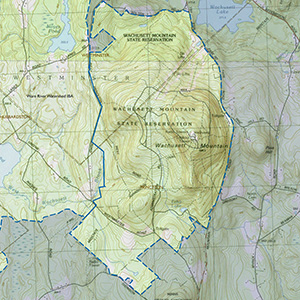Important Bird Area Sites in Massachusetts
Important Bird Area: Wachusett Mountain
Site Summary
Nominated By
Paul Roberts
Size
2,000 acres
Towns and Counties
Princeton, Westminster; Worcester
Ownership
Department of Conservation and Recreation
Major Habitats
5% spruce-fir forest, 10% northern hardwoods forest, 70% oak-conifer forest, 5% early successional shrubland, 2% cultural grassland, emergent freshwater wetland, 2% palustrine woodland swamp, 4% shrub-scrub wetland, 2% lake/pond, hawk-watching site
Land Use
nature & wildlife conservation/land trust, hunting/fishing, other recreation or tourism, forestry, water supply, undeveloped
Serious Threats
deforestation, habitat conversion, cellular towers, disturbance to birds or habitat, recreational development/overuse
Minor Threats
water/air pollution, residential/commercial development
IBA Criteria
- Category 5: Sites important for long-term research and/or monitoring projects that contribute substantially to ornithology, bird conservation, and/or education.
Site Description
Wachusett Mountain (2,006 feet) is the highest point of land in eastern and central Massachusetts. Located in Princeton and Westminster, the mountain is within the Wachusett Mountain State Reservation, which draws more than three-quarters of a million visitors a year, from hawk watchers, hikers, and fall-foliage viewers to skiers and snowboarders. The reservation is primarily woodlands that offer approximately 15 miles of hiking trails, which are excellent for watching birding and observing wildflowers. Wachusett Mountain State Reservation borders the 1,000-acre Wachusett Meadow Wildlife Sanctuary owned by Mass Audubon, and is in proximity to the 139-acre Susan B. Minns Wildlife Sanctuary managed by MassWildlife. Together these properties provide an unusually large block of woodland habitat for public education and recreation.
Current Conservation Status
The mountain is managed by the Department of Conservation and Recreation (DCR). In the Resource Management and Protection Plan, Wachusett Mountain State Reservation (1999), increasing diverse recreational demand is listed as being a large, broad threat. From a hawk-watching perspective, there are several serious concerns. First, because tree cutting has been curtailed, views for hawk-watchers have diminished and will continue to be reduced. Second, there are plans to modify the summit by requiring automobile parking, except for handicapped individuals, to be at satellite lots below the summit, and to build an observation platform for foliage viewing, general tourism, and hawk watching. The possible construction of a viewing platform can have a serious negative impact on the ability to hawk watch and the quality of the hawk-watching experience on the summit. Additional concerns include the impacts of flying kites, toy aircraft, and hang gliders from the summit, and the invasiveness of recreational/sightseeing aircraft buzzing the summit during migratory periods.
Ornithological Significance
Wachusett Mountain has been documented as one of the premier hawk migration and observation sites in the Northeast. The mountain's predominantly bare summit affords excellent views in nearly all directions, ideal for hawk watching. The reservation provides an unusual opportunity to educate and inform the public about hawks, their significance, and the role of the mountain in hawk migration. A series of short hills to the northeast of Wachusett including Monoosnock and the Crow Hills combine with the higher, fairly steep slopes of Wachusett Mountain to provide excellent sources of lift, both thermal and orographic, for thousands of migrating hawks under appropriate weather conditions. These hawks, many of which seek lift here for ease of flight, migrate from northeastern New England and the Canadian Maritimes to the central and southern US and beyond. Since 1976, counts by the Eastern Massachusetts Hawk Watch have produced over 300,000 migrant hawks, with an average of 12,102 hawks per year for the past 25 years. The most abundant species by far is the Broad-winged Hawk, which averages 10,995 per year, with peak seasonal counts of 27,090 and 26,910 in 1984 and 1983, respectively. No other sites in Massachusetts, and only a few in New England, have reported flights of this magnitude. The largest single-day flights ever reported in Massachusetts have been at Wachusett: 20,106 on 9/13/83; 17,517 on 9/17/84; and 16,062 on 9/13/89.
Other Flora or Fauna of Significance
The reservation is home to at least ten species that are of special significance to the Massachusetts Natural Heritage and Endangered Species Program. Wachusett Mountain State Reservation also includes one the largest known stand of old growth forest in Massachusetts (100 acres). Several trees have been found on the mountain, including Red Oak, Black Birch, and Yellow Birch, that are at or very near the maximum longevity known for the species. The mountain also has a much higher diversity of lichen species (150) than found elsewhere in second-growth forest in the state, including several species rarely collected in Massachusetts and one possibly new to science.
Data Sources
Since 1976, over 3,300 hours of fall hawk migration coverage provided by the Eastern Massachusetts Hawk Watch. Data are also reported to the NorthEast Hawk Watch (NEHW) and the Hawk Migration Association of North America (HMANA). Those observations have been published on a bimonthly, seasonal, and annual basis by the respective organizations as noted below.
Spring Report, Eastern Massachusetts Hawk Watch, published annually since 1977.
Fall Report, Eastern Massachusetts Hawk Watch, published annually since 1976.
HMANA Hawk Migration Studies Hawk Migration Association of North America, published semiannually beginning in September 1976.
Northeast Hawkwatch Report, NorthEast Hawk Watch, published annually since 1976.
"Bird Sightings," Bird Observer, published bimonthly since 1976.
Raptor Watch: a global directory of raptor migration sites. Zalles, J. I., and Bildstein, K.L., eds (2000). Cambridge, UK: BirdLife International; and Kempton, PA, USA: Hawk Mountain Sanctuary (BirdLife Conservation Series No. 9)
Department of Environmental Management. 1999. Resource Management and Protection Plan, Wachusett Mountain State Reservation.




